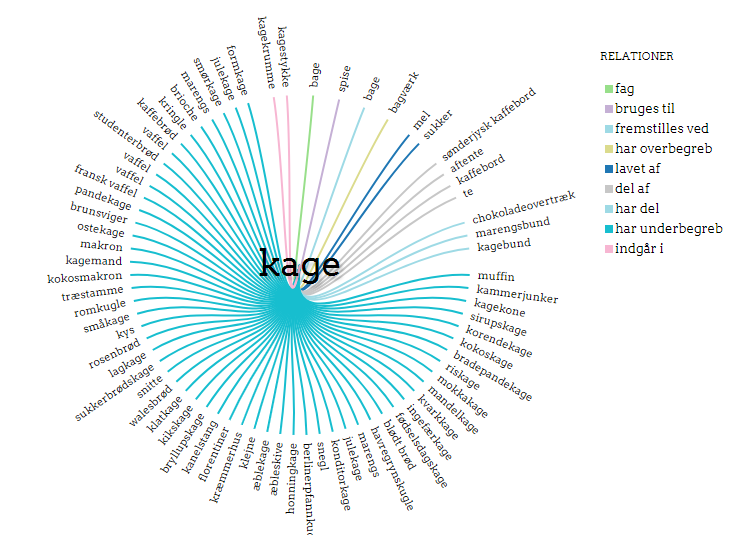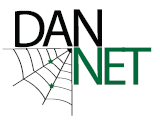DanNet
DanNet is a WordNet which is a lexico-semantic network graph that shows how senses of a language relate to others through named relations. One can also think of a WordNet as a kind of machine-readable dictionary.
On wordnet.dk/dannet you can not only browse, but also download the newest versions of multiple data sets.
Unlike a normal dictionary, the definitions of words aren't central; instead, relations to other words are the important part. For example, in DanNet you can see that a Swiss willow is a kind of bush, that a gazebo is located in a garden, that "fiberdrys" is for eating, and that cakes are typically produced by baking and usually made from flour and sugar.

On andreord.nors.ku.dk you can generate the above illustration based on an older version of DanNet. In the future, you will be able to find similar illustrations based on the newest data at wordnet.dk/dannet.
All in all, the wordnet currently contains around 70 thousand concepts kept together by approximately 500 thousand relations.
The wordnet and the methods behind it are best described in:
Bolette S. Pedersen, Sanni Nimb, Jørg Asmussen, Nicolai H. Sørensen, Lars Trap-Jensen og Henrik Lorentzen. DanNet – the challenge of compiling a WordNet for Danish by reusing a monolingual dictionary. Lang Resources & Evaluation (2009) 43:269–299.
DanNet has been developed on the basis of Den Danske Ordbog (the Danish Dictionary) as a collaborative work between the University of Copenhagen (Centre for Language Technology) and The Danish Society for Language and Literature. Funding was provided by the Danish Research Council via the project DanNet – et leksikalsk-semantisk ordnet for dansk, and the wordnet has been developed further in related projects, namely CLARIN-DK, METANORD, Semantic Processing across Domains and ELEXIS.
The wordnet has been semi-automatically compiled under varying funding and staffing conditions – as indicated above. Therefore we make reservations concerning errors and omissions. Observed errors and omissions can be reported to bspedersen@hum.ku.dk.
A subpart of the vocabulary has been linked to English, Swedish, Finnish and Estonian: WordTies: A Nordic/Baltic Multilingual Wordnet Initiative. In connection with the ELEXIS project we plan to link the entire wordnet to the corresponding English resource, Princeton WordNet, in order to be able to use the resource cross-lingually.
You can download the DanNet resource in two separate formats. By downloading a data set, you accept the CC BY-SA 4.0 license:
- RDF data set (the primary resource)
- A single TTL file that should now be considered the main resource.
- CSV data set (an alternative format)
- This ZIP file contains several CSV files as well as CSVW metadata, which collectively can be used to recreate most of the contents of the RDF resource.
Several other RDF data sets can also be downloaded at wordnet.dk/dannet. These alternative data sets can be used to extend the primary RDF resource with other useful data.
When referencing the resource, please use this article: Bolette S. Pedersen, Sanni Nimb, Jørg Asmussen, Nicolai H. Sørensen, Lars Trap-Jensen og Henrik Lorentzen. DanNet – the challenge of compiling a WordNet for Danish by reusing a monolingual dictionary (pdf). Lang Resources & Evaluation (2009) 43:269–299.
Get linguistic specifications
Please note that these specifications are based on an older version of DanNet. However, they should still allow for understanding the contents of the DanNet resource; just be aware that the names of certain relations/attributes may have changed.
- Main publication: Pedersen, Bolette S. Sanni Nimb, Jørg Asmussen, Nicolai H. Sørensen, Lars Trap-Jensen og Henrik Lorentzen (2009). DanNet – the challenge of compiling a WordNet for Danish by reusing a monolingual dictionary. Lang Resources & Evaluation 43:269–299.
- Pedersen, Bolette S.; Aguirrezabal Zabaleta, Manex; Nimb, Sanni; Olsen, Sussi; Rørmann, Ida. (2018) Towards a principled approach to sense clustering – a case study of wordnet and dictionary senses in Danish. Proceedings of Global WordNet Conference 2018. Singapore, 2018.
- Pedersen, Bolette Sandford; Nimb, Sanni; Olsen, Sussi; Sørensen, Nicolai Hartvig. (2018). Combining Dictionaries, Wordnets and other Lexical Resources - Advantages and Challenges. Globalex Proceedings 2018, Miyasaki, Japan. 2018.
- Sanni Nimb, Bolette S. Pedersen, Anna Braasch, Nicolai H. Sørensen & Thomas Troelsgård (2013) Enriching a wordnet from a thesaurus. Workshop Proceedings on Lexical Semantic Resources for NLP from the 19th Nordic Conference on Computational Linguistics (NODALIDA). Linköping Electronic Conference Proceedings; Volume 85 (ISSN 1650-3740).
- Sanni Nimb, Bolette Sandford Pedersen (2012).Towards a richer wordnet representation of properties – exploiting semantic and thematic information from thesauri. LREC 2012 Proceedings. Istanbul, Turkey
- Bolette S. Pedersen, Sanni Nimb, Anna Braasch (2010). Merging specialist taxonomies and folk taxonomies in wordnets – a case study of plants, animals and foods in the Danish wordnet. Proceedings from 7th Conference on Language Resources and Evaluation, LREC. Malta
- Henrik Lorentzen, Sanni Nimb (2010). Fra ordbog til wordnet. Hvordan udmøntes en ordbogsdefinition i en formaliseret wordnetbeskrivelse?. Harry Lönnroth & Kristina Nikula (red.) (2010): Nordiska studiar i lexikografi 10. Rapport från Konferencen om lexikografi i Norden, Tammerfors 3-5 juni 2009, pp. 329-344. Tammerfors
- Sanni Nimb, Lars Trap-Jensen (2009). Use, Re-use and Synergetic Benefit: The Interplay between WordNet and Dictionary Data« . I: GSCL Forum – Special Issue on Lexical-Semantic and Ontological Resources. German Society for Computational Linguistics. 19. s.
- Bolette S. Pedersen, Sanni Nimb (2009). Et net af ord. K. Farø, A. Holsting, N.Larsen, J.E. Mogensen & T.Vinther (eds). Sprogvidenskab i glimt. 70 tekster om sprog i teori og praksis. Syddansk Universitetsforlag, s.112-117.
- Pedersen, B.S. & A. Braasch (2009). What do we need to know about humans? A view into the DanNet Database. In: K. Jokinen and E. Bick (eds.) Proceedings of the 17th Nordic Conference of Computational Linguistics NODALIDA 2009. NEALT Proceedings Series, Vol. 4, Odense, Denmark.
- Sanni Nimb (2009). The Semantic Relations of Artifacts in DanNet. In B.S. Pedersen, A.Braasch, S.Nimb, R. Vatvedt Fjeld (eds.): Proceedings of the NODALIDA 2009 workshop "WordNets and other Lexical Semantic Resources - between Lexical Semantics, Lexicography, Terminology and Formal Ontologies" NEALT Proceedings Series, Vol. 7 Published by Northern European Association for Language Technology (NEALT), Electronically published at Tartu University Library (Estonia)
- Pedersen, B.S., A. Braasch, S. Nimb, R. V. Fjeld (eds) (2009). WordNets and other Lexical Semantic Resources - between Lexical Semantics, Lexicography, Terminology and Formal Ontologies. In: Proceedings of the NodaLida 2009 Workshop, NEALT Proceedings Series, Vol. 7, Odense, Denmark. (elektronisk publicering, derfor ingen sidetal).
- Sanni Nimb & Lars Trap-Jensen (2008): Use, Re-use and Synergetic Benefit: The Interplay between WordNet and Dictionary Data. In: GSCL Forum – Special Issue on Lexical-Semantic and Ontological Resources. German Society for Computational Linguistics.
- Pedersen, B.S., S. Nimb & L. Trap-Jensen. (2008). DanNet: udvikling og anvendelse af det danske wordnet. In: Nordiske Studier i leksikografi Vol. 9, Skrifter udgivet af Nordisk Forening for Leksikografi, pp. 353-370
- Pedersen, B.S. & A. Braasch, L. Henriksen, S. Olsen and C. Povlsen (2008). Merging a Syntactic Resource with a WordNet: a Feasibility Study of a Merge between STO and DanNet. In: Proceedings from the sixth International Conference on Language Resources and Evaluation 2008. Marrakech, Marokko, pp. 1-5.
- Pedersen, B.S., S. Nimb, L. Trap-Jensen (2008): DanNet: udvikling og anvendelse af det danske wordnet. In: Ásta Svavarsdóttir, Guðrún Kvaran, Gunnlaugur Ingólfsson, Jón Hilmar Jónsson (eds): Nordiske Studier i Leksikografi 9, NFL-skrift nr. 10, Reykjavík 2008, s. 351-367
- Pedersen, B.S. & S. Nimb. (2008). Event Hierarchies in DanNet. In: A. Tanács, D. Csendes, V. Vincze, C. Fellbaum, & P. Vossen (eds) Proceedings of Global WordNet Conference, Szeged, Hungary 22-25, pp. 339-349.
- Nimb, Sanni & Nicolai Sørensen (2007): DanNet — et leksikalsk-semantisk WordNet for dansk. In: Peter Widell & Ulf Davad Berthelsen (eds.): 11. Møde om Udforskningen af Dansk Sprog. Århus, Danmark, s. 191-2000.
- Pedersen, B.S., P. Paggio & C. Navarretta. (2007). Sprogteknologiske ressourcer til informationss�gning, in: M. L. Nielsen (ed.) Dansk Biblioteksforskning - Tidsskrift for informations- og kulturformidling 3 (2), p. 5-18.
- Asmussen, J. Pedersen, B.S. & Trap-Jensen, L. (2007). DanNet: From Dictionary to WordNet. Kunze, C., Lemnitzer, L. & Osswald, R. (eds.) GLDV-2007 Workshop on Lexical-Semantic and Ontological Resources 1-11. Universität Tübingen, Tyskland.
- Pedersen, Bolette S. & Nicolai Sørensen (2006): Towards sounder taxonomies in Wordnets. In: Alessandro Oltramari, Chu-Ren Huang, Alessandro Lenci, Paul Buitelaar, Christiane Fellbaum (eds.): Ontolex 2006, pp. 9-16. Genova, Italy.
- Pedersen, B.S., S. Nimb, N., J. Asmussen, N. Sørensen, L. Trap-Jensen, H. Lorentzen (2006). DanNet - A WordNet for Danish. In: Proceedings from Third International Conference on Global Wordnets, pp. 329-331. Jeju, South Corea.
- Paggio, P. & B.S. Pedersen (2006). Bedre adgang til viden - Informationssøgning med ontologi og sprogteknologi. In: A. Braasch, C. Navarretta, S. Nimb, S. Olsen, P. Paggio, B.S. Pedersen & J. Wedekind (eds.) Sprogteknologi i et dansk perspektiv - En samling artikler om sprogforskning og automatisk sprogbehandling pp. 329-354. Reitzels Forlag, København.
- Pedersen, B.S., & J. Asmussen (2006). DanNet - Fra ordbog til et leksikalsk-semantisk WordNet for dansk I: Leda-Nyt pp. 3-12.København.
- Asmussen, Jørg (2006): Korpuslinguistische Verfahren zur Optimierung lexikalisch-semantischer Beschreibungen. In: Jahrbuch des Instituts für Deutsche Sprache 2006. Mannheim, Germany.
Professor Bolette S. Pedersen
Centre for Language Technology
Department of Nordic Studies and Language Technology
bspedersen@hum.ku.dk
Senior editor Sanni Nimb
The Danish Society for Language and Literature
sn@dsl.dk
Funding
In the period 2018-2020, the Carlsberg Foundation's infrastructure initiative supports an upgrade of DanNet which involves expansion and update of the resource on the basis of The Danish Thesaurus as well as linking to English.
The project takes place in collaboration between The Society for Danish Language and Literature and UCPH.
Partners
DanNet has been compiled in a collaboration between Centre for Language Technology, University of Copenhagen, and the Danish Society for Language and Literature.



